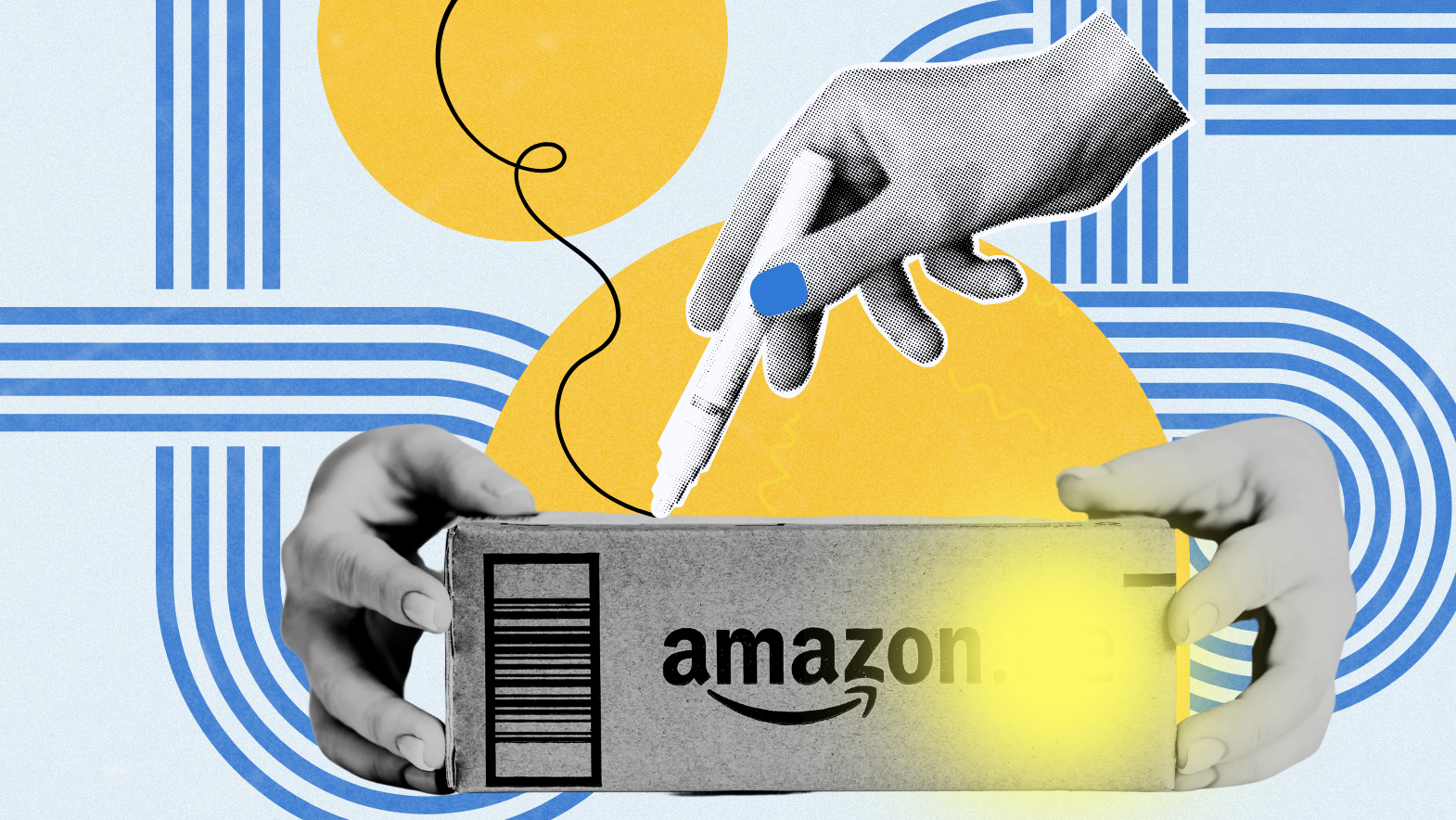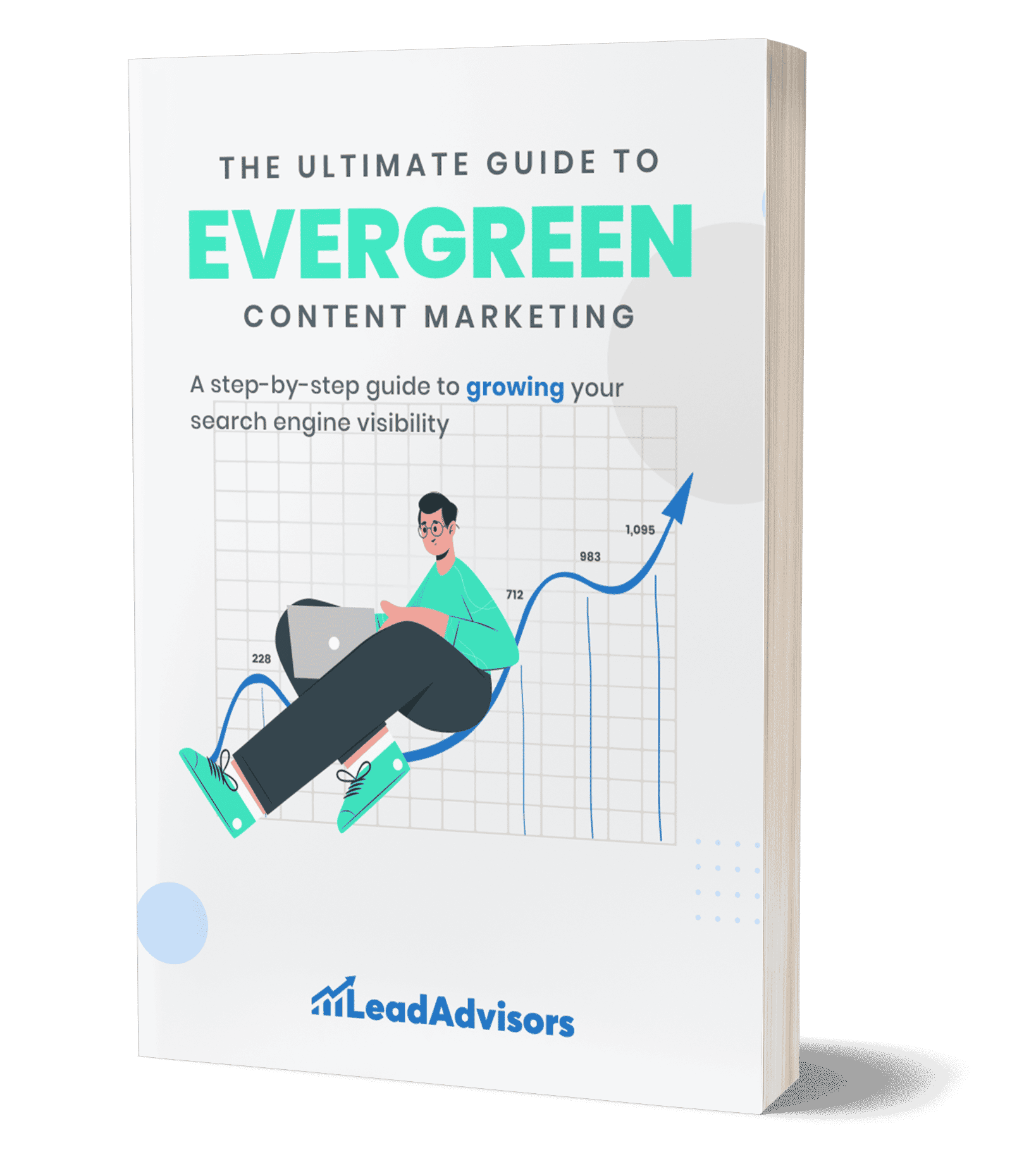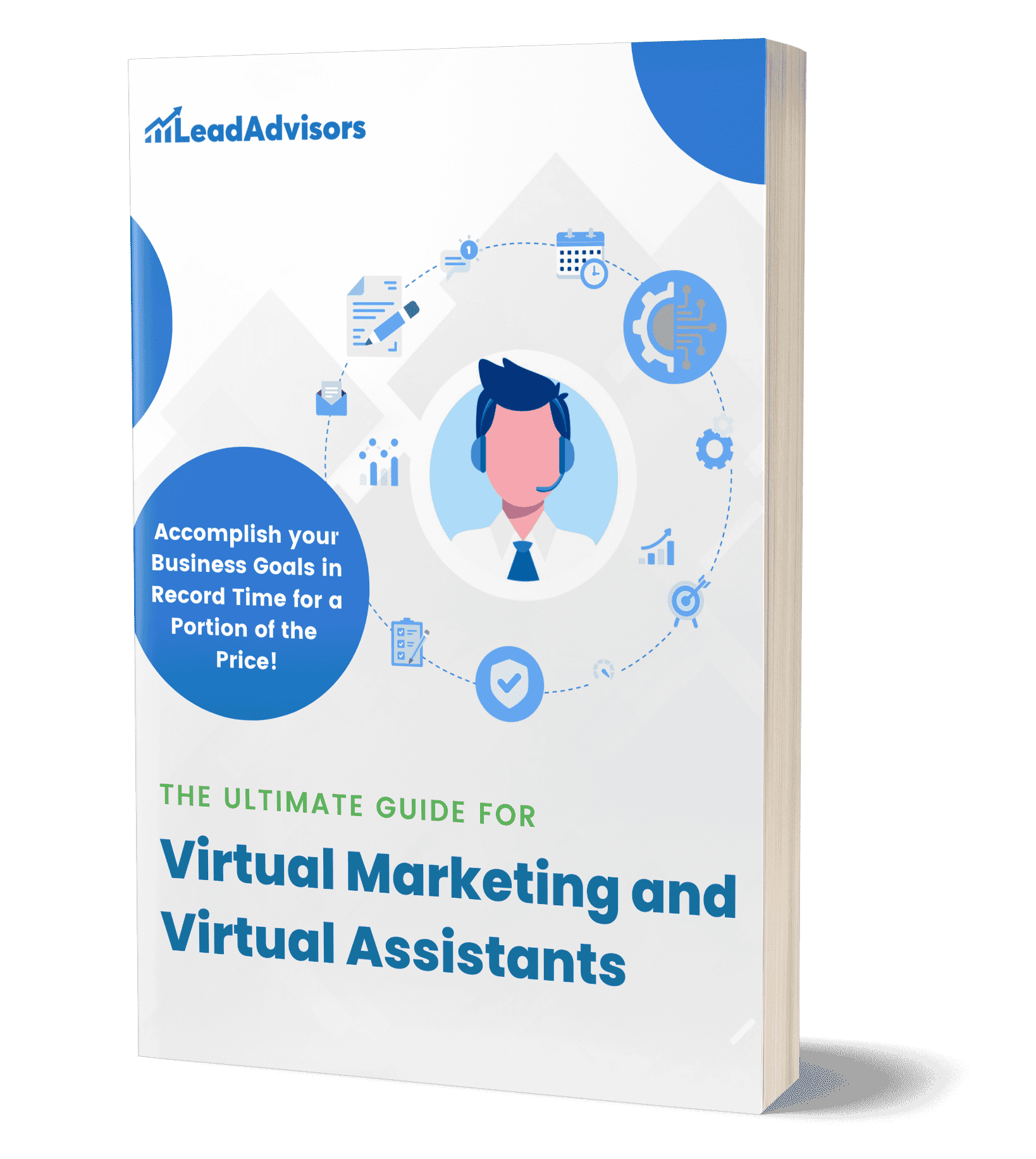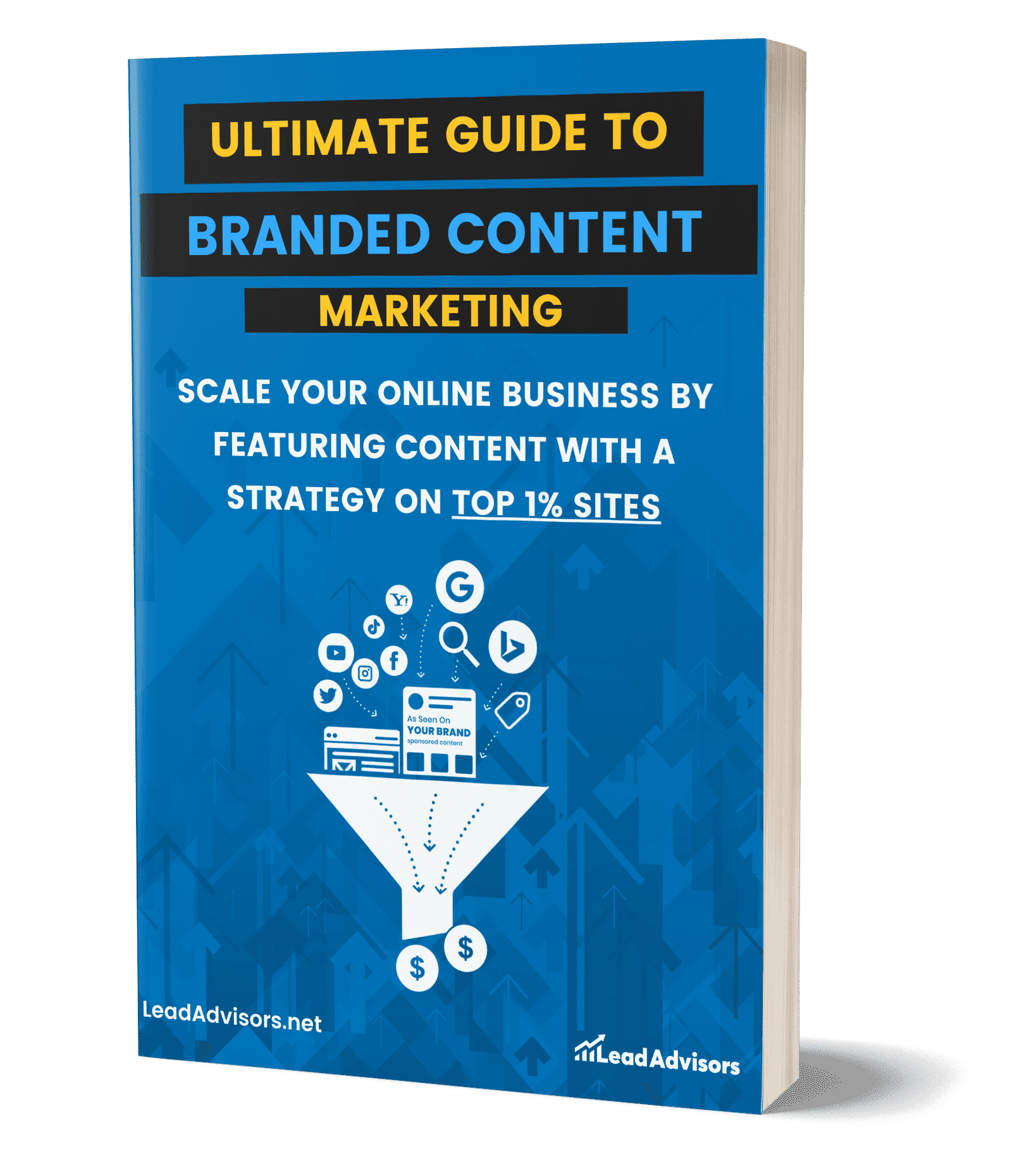Have you ever opened Amazon and suddenly realized that you have been reading reviews for longer than you planned? Yeah, it’s the same.
After all, these days, reviews can make or break a product. In fact, since so many of us shop online, sellers are always searching for honest and unbiased reviews that actually help others decide if something’s worth it.
That’s where Amazon product reviewers are key. You may have heard about people getting free products or even participating in programs such as Amazon Vine. Sounds pretty cool, right? But it’s not just a matter of grabbing freebies and typing out a few sentences.
This blog is for you if you’re:
- Curious about how people become reviewers on Amazon?
- Wondering how programs such as Amazon Vine REALLY work
- A brand would like to see more insightful reviews without violating the rules.
- Or just trying to determine whether or not those paid reviews you keep hearing about are even legitimate.
Let’s keep it real here—we all know what works and what doesn’t, especially when it comes to getting informative reviews that most people actually trust.
If you’re looking to get detailed feedback on your products or even review some things yourself, it’s time to stick around. This guide has what you need—no fluff, no gimmicks.
TL;DR
Amazon Vine Program:
Invite-only for trusted reviewers
Offers free products in exchange for honest reviews
Good for new products to build initial reviews and trust
Affiliate Editorial Reviews:
Expert-written, featured on high-authority websites
Optimized for SEO, providing lasting organic traffic
Full control over messaging and product placement
Ideal for scaling brands and agencies seeking long-term visibility
Which to Choose:
Hobbyists/New Product Brands: Amazon Vine + Affiliate Editorial Reviews
Growth-Stage/Established Brands: Focus on Affiliate Editorial Reviews for credibility and SEO
Agencies: Use editorial reviews as content assets for a full-funnel strategy
What Is an Amazon Product Reviewer?
An Amazon product reviewer is more or less a person who offers their opinion based on a product they have tried. That’s it. No fancy title needed. Whether a mom is reviewing baby bottles or a software developer is putting the latest smart home device through its paces, these are the reviews other shoppers rely upon when they are about to click “Buy Now.”
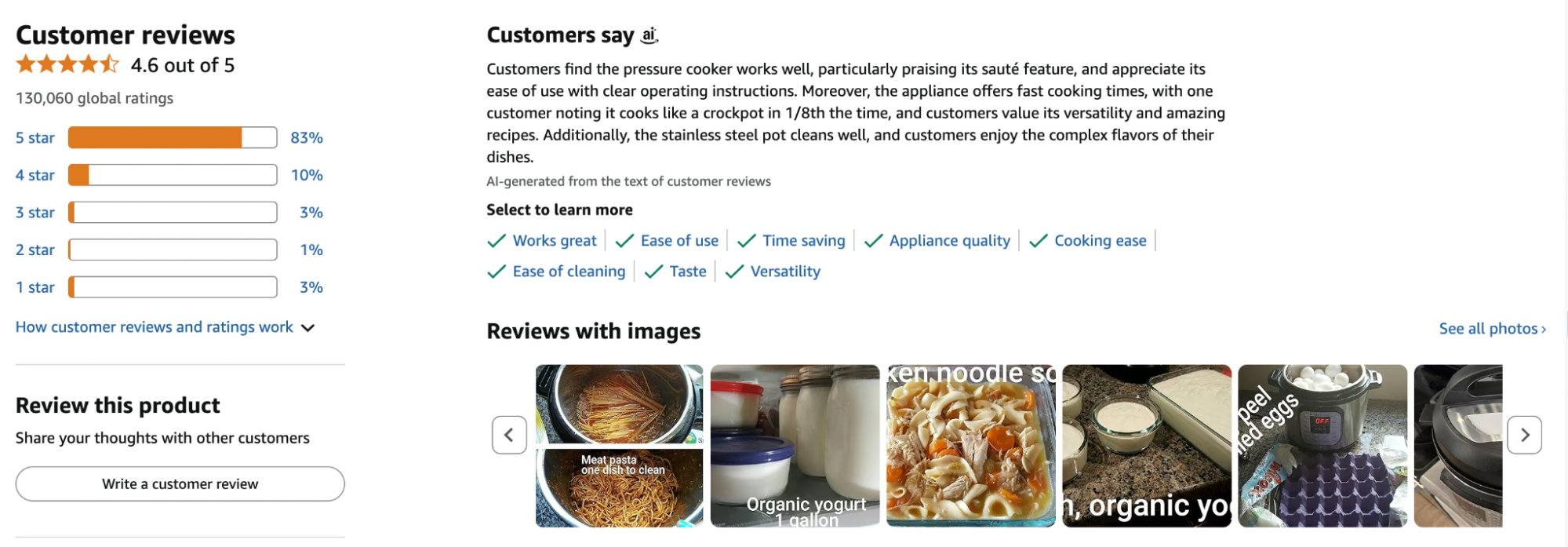
However, there are a few different types of reviewers — each with a slightly different role to play.
Some are average people who simply do or do not share their honest feedback because they had a pretty good (or really terrible) experience. These are referred to as organic reviewers. Product testers are those who receive free or discounted products in exchange for their feedback.
And, of course, there are the Amazon Vine participants —Amazon selects these to leave informative reviews after they try out items sent directly from sellers.
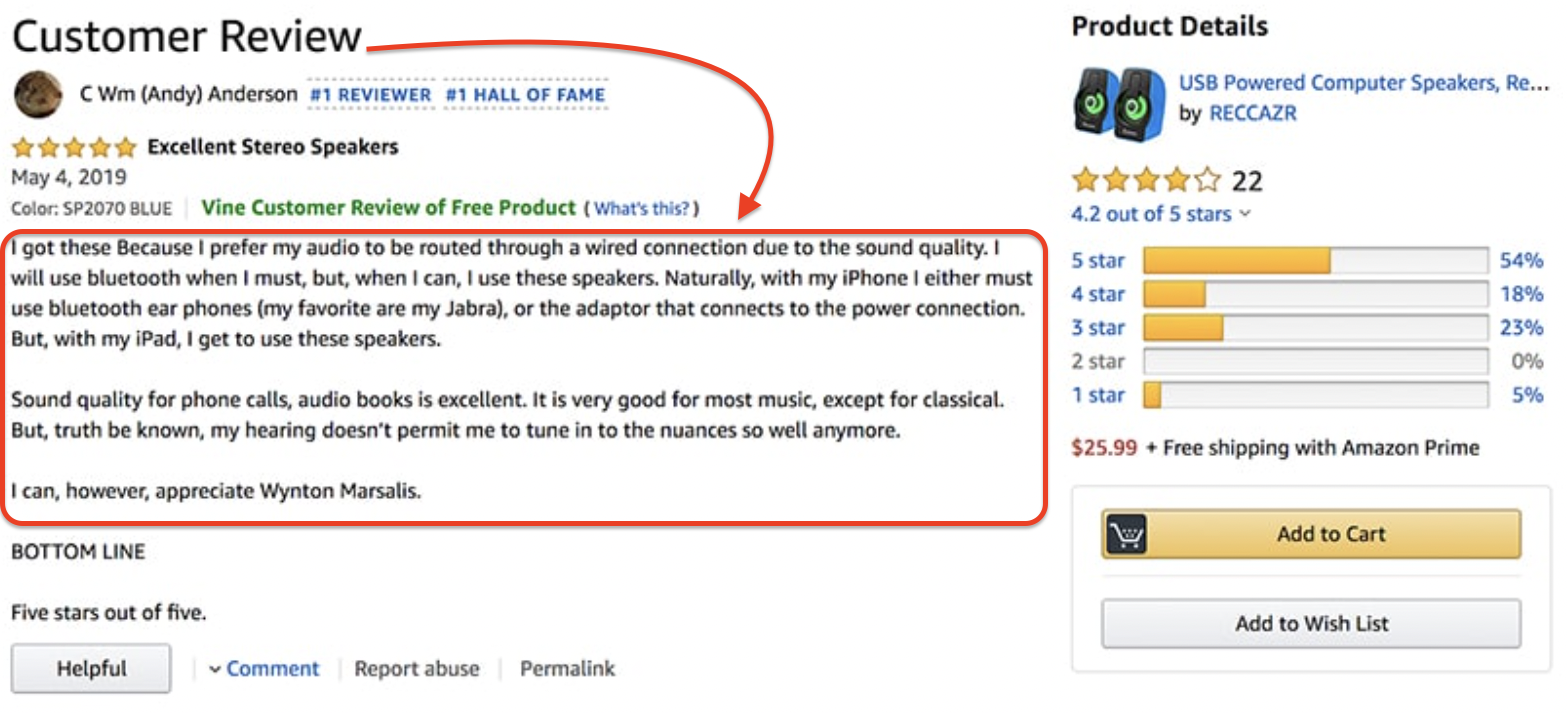
So why do brands care so much about Amazon reviews? Easy:
- They create trust among potential buyers.
- They increase conversions (because let’s face it—you don’t want to be the first person to attempt something untested)
- And they also help products climb higher in the ranks of Amazon, meaning they are more visible.
In other words, whether you’re giving away free stuff or asking someone for their honest opinions, good reviews can make a difference.
How the Amazon Vine Program Works
Let’s discuss the Amazon Vine program — reviewer club, which is sort of a big deal.
So, what is Vine?
Amazon is trying to encourage honest product feedback by giving discounted items to its most trusted reviewers for free. But you can’t just sign up for this yourself. It’s invite-only, and Amazon selects from among an elite group of Amazon customers who have proven to be good at giving useful feedback.
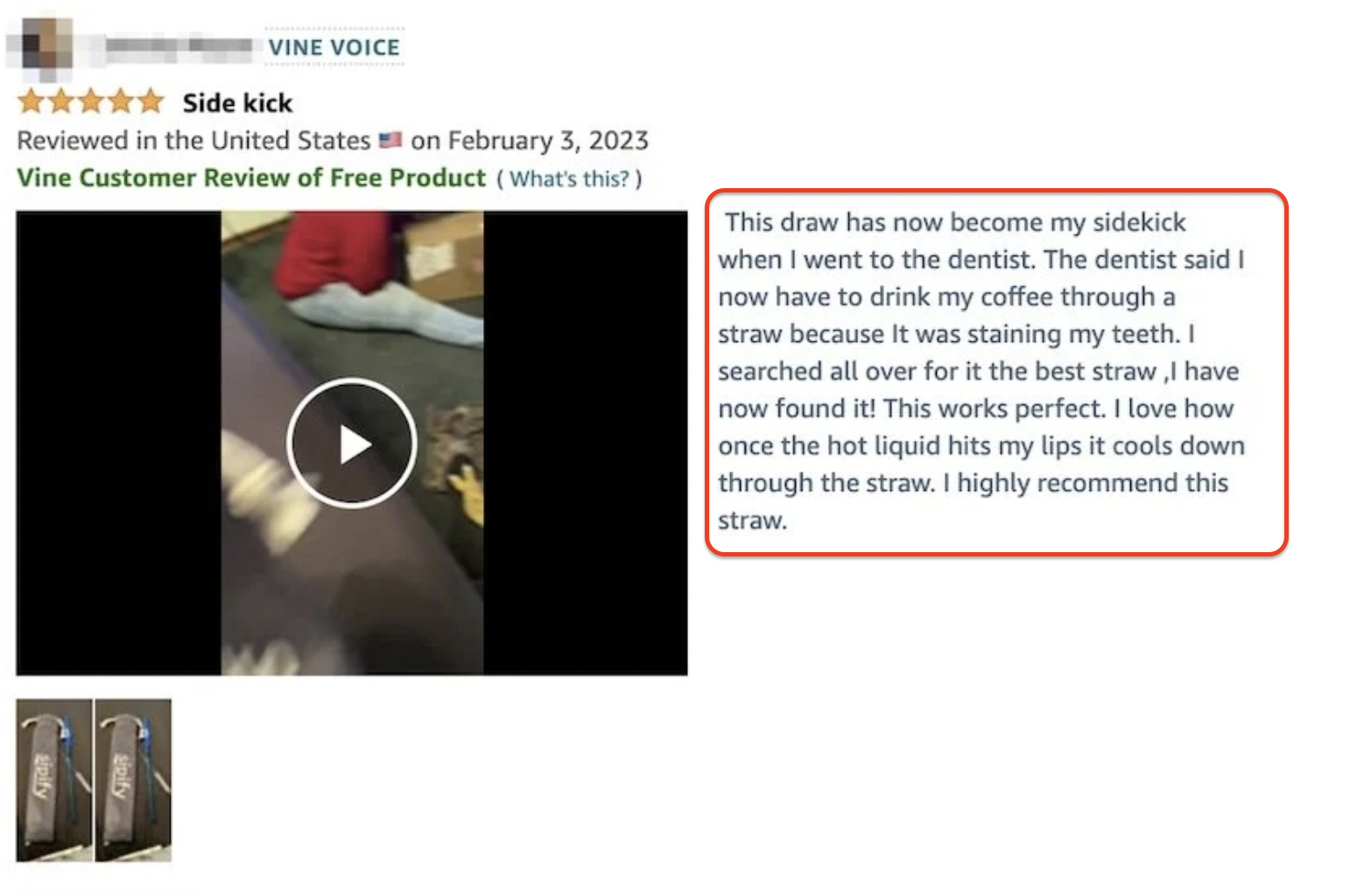
These are not reviewers just grabbing for freebies and then skedaddling. They’re those who author honest, informational opinions that are way beyond “it’s great” or “it broke.”
Who actually gets invited?
Vine is an invite-only program, so you need to be a reasonably active Amazon reviewer already. If you’ve been leaving helpful reviews — and especially the types of people who have upvoted or commented on — Amazon might be paying attention. A strong, healthy Amazon account with lots of activity can also be beneficial.
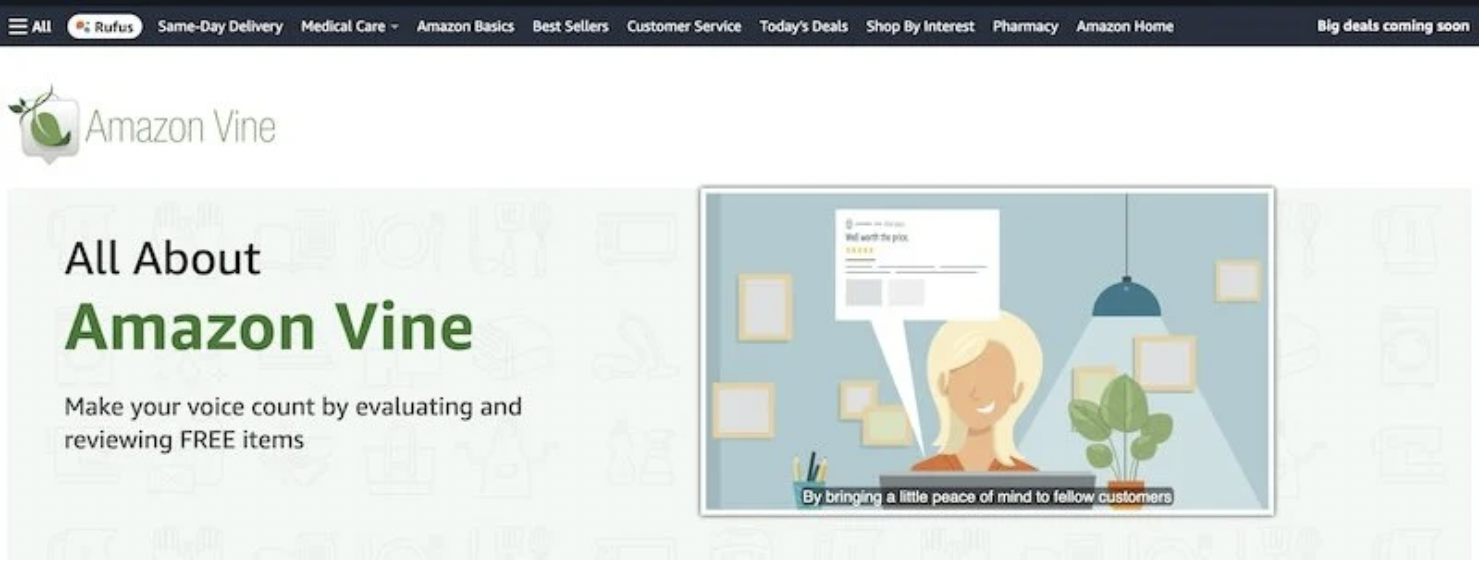
In short, Amazon wants people who like reviewing stuff and who post consistently strong, helpful reviews.
What brands like about Vine
If you’re launching a new product, it can be difficult to collect those first few product reviews. Vine speeds that up. Your product is now in the hands of real customers who will test it out, write about it, and add it to your listing.
Such early access can help build trust and generate interest, even if the news isn’t always fawning.
The not-so-fun part for sellers
Here’s what sellers need to know before diving in:
- You don’t get to choose who reviews your stuff
- You can’t ask for a positive review (and that’s good for shoppers)
- Vine is a little aid for SEO and/or reading longevity and visibility—reviews remain on Amazon.
Attempting to give away or discount things that aren’t part of the program is a big no-no. Amazon’s rules are strict, and it does take review integrity seriously.
If you’re interested in the complete rundown, here’s the Amazon Vine Program page.
How to Become an Amazon Product Reviewer
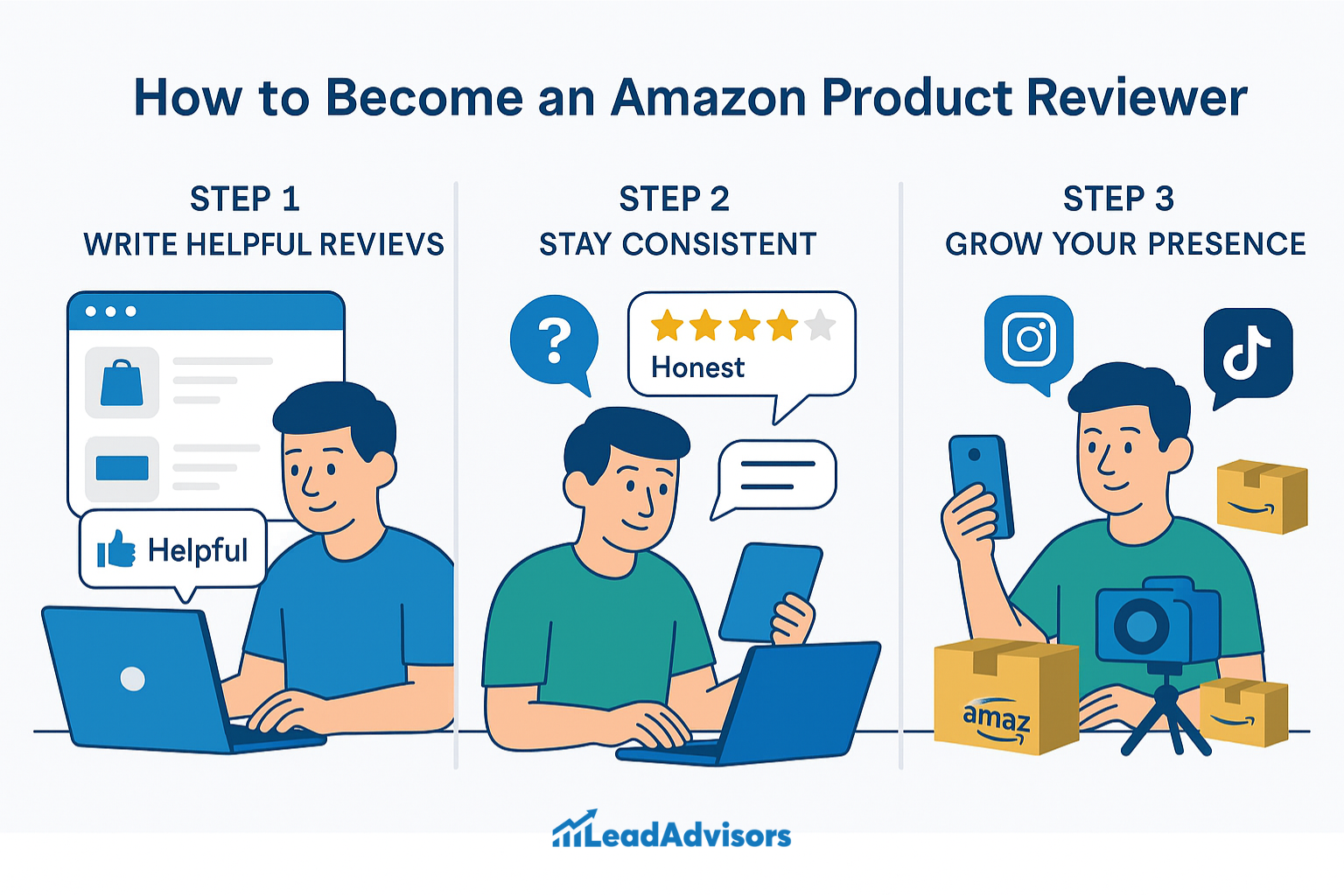
Ever wonder how some people end up reviewing products all the time, or even get invited to the Amazon Vine program where they’re sent items for free?
It’s not luck. It’s consistency, trust, and being genuinely helpful to other shoppers.
Here’s how to build your way up and increase your chances of becoming a go-to Amazon product reviewer.
1. Build a Review History on Amazon
Start by reviewing things you’ve already purchased—yes, even the little stuff. The key is to build a consistent review trail that shows you’re an active customer with genuine experiences to share.

Example:
Instead of writing “Great charger!” for a phone cable, try:
“Charges my iPhone 13 quickly and fits snugly into the port. The cable is thicker than expected, which makes it feel durable. Used it daily for two weeks with no issues.”
That kind of detailed feedback helps real people, and Amazon notices it.
2. Write Helpful, Detailed Reviews
Think like a shopper. What would you want to know before buying?
Be specific. Mention what stood out, what could be better, and who the product is actually good for.
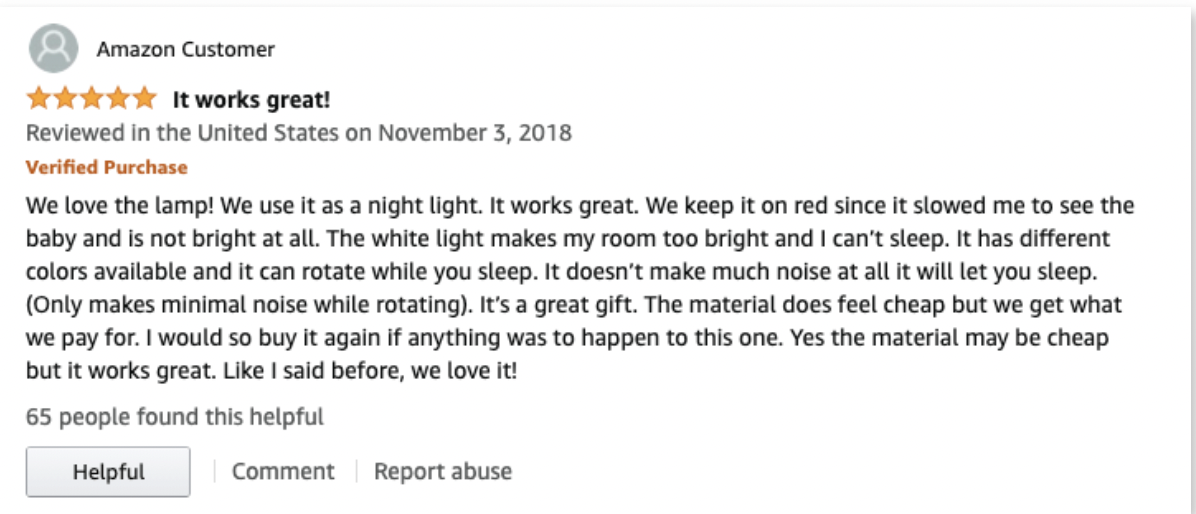
Example:
“For a night light lamp:
“We use this lamp as a night light in our baby’s room and love it. The red light setting is perfect—soft enough that it doesn’t disturb sleep but still lets us see clearly during nighttime feedings. The white light is too bright for us, so we avoid it at night…….”
That’s more valuable than saying, “It works fine.”
Bonus tip: Break up your reviews with short paragraphs or bullet points for readability. Long walls of text = scroll past.
3. Engage with the Amazon Community
Amazon has features that go beyond just reviews. You can answer questions on product pages, comment on other reviews, or even follow helpful reviewers.
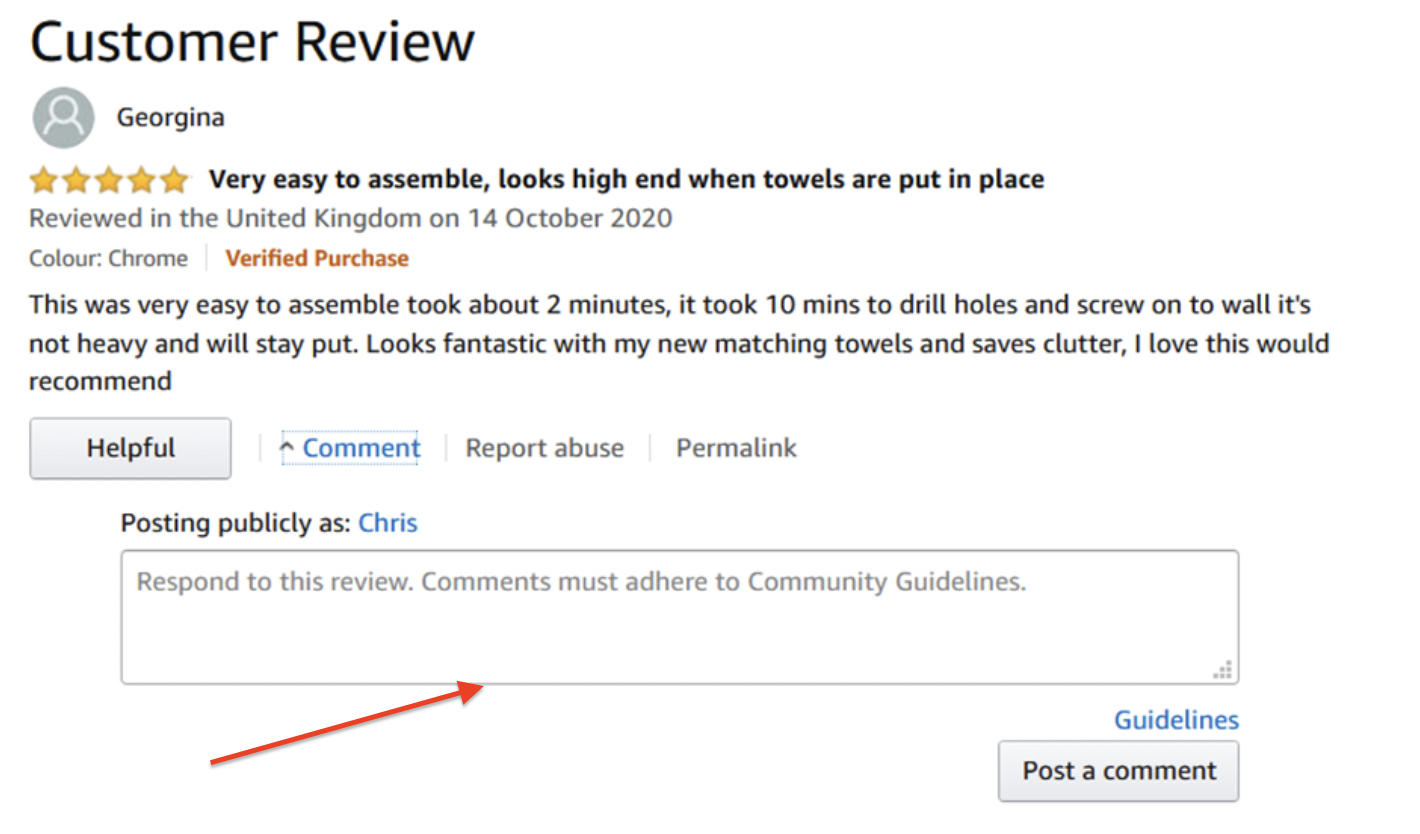
The more active you are, the more credible you look.
Example:
Reply to a product question like,
“Yes, the power bank works with both USB-C and Lightning cables. I use it with my iPad and iPhone, and it charges both just fine.”
It shows you’re not just a buyer—you’re someone contributing to the community.
4. How Amazon Vine Invitations Work
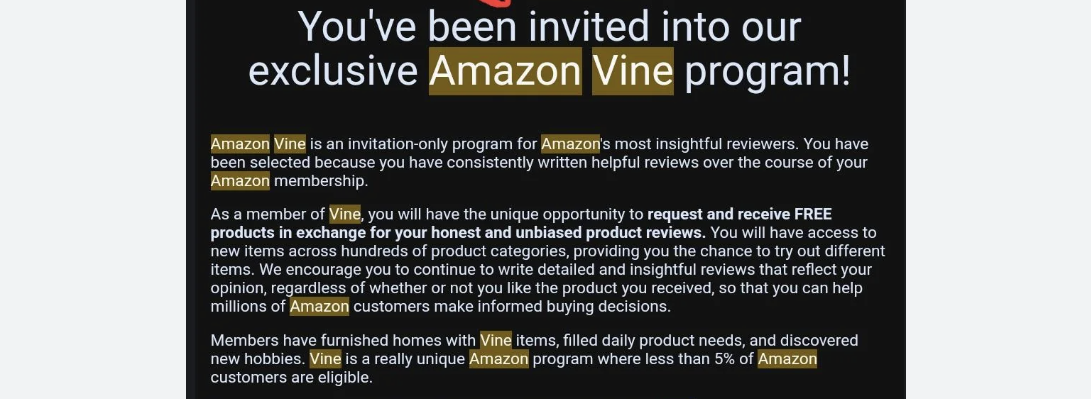
You can’t apply to Amazon Vine. Amazon handpicks reviewers based on:
- Frequency of reviewing
- Helpfulness ratings from other shoppers
- Overall contribution to the platform
They’re looking for people who consistently provide quality reviews and engage in helpful ways, not just those who post when something breaks.
Example:
If you’ve written 50+ detailed, honest reviews and regularly respond to questions or get “helpful” votes, you’re more likely to be noticed.
And even then, it’s not instant. Some reviewers say they were active for a year or two before receiving an invite.
- Set Realistic Expectations
Here’s the part a lot of people don’t mention: reviewing is mostly unpaid. Even in Vine, you might receive free products, but there’s no money involved.
Plus, product availability is limited. Sometimes you’ll have tons of review offers. Other times, nothing for weeks.
Also worth noting:
Many third-party “tester” programs exist, but not all of them follow Amazon’s Terms of Service. Be careful. If someone asks you to write a 5-star review in exchange for cash or reimbursement, it’s likely against the rules—and that can put your Amazon account at risk.
Exploring “Reviewer Jobs” and What Brands Should Know
You’ve seen the ads. Some random site says that you can get paid to leave reviews on new products (and maybe score some free stuff and perhaps even make a little cash).
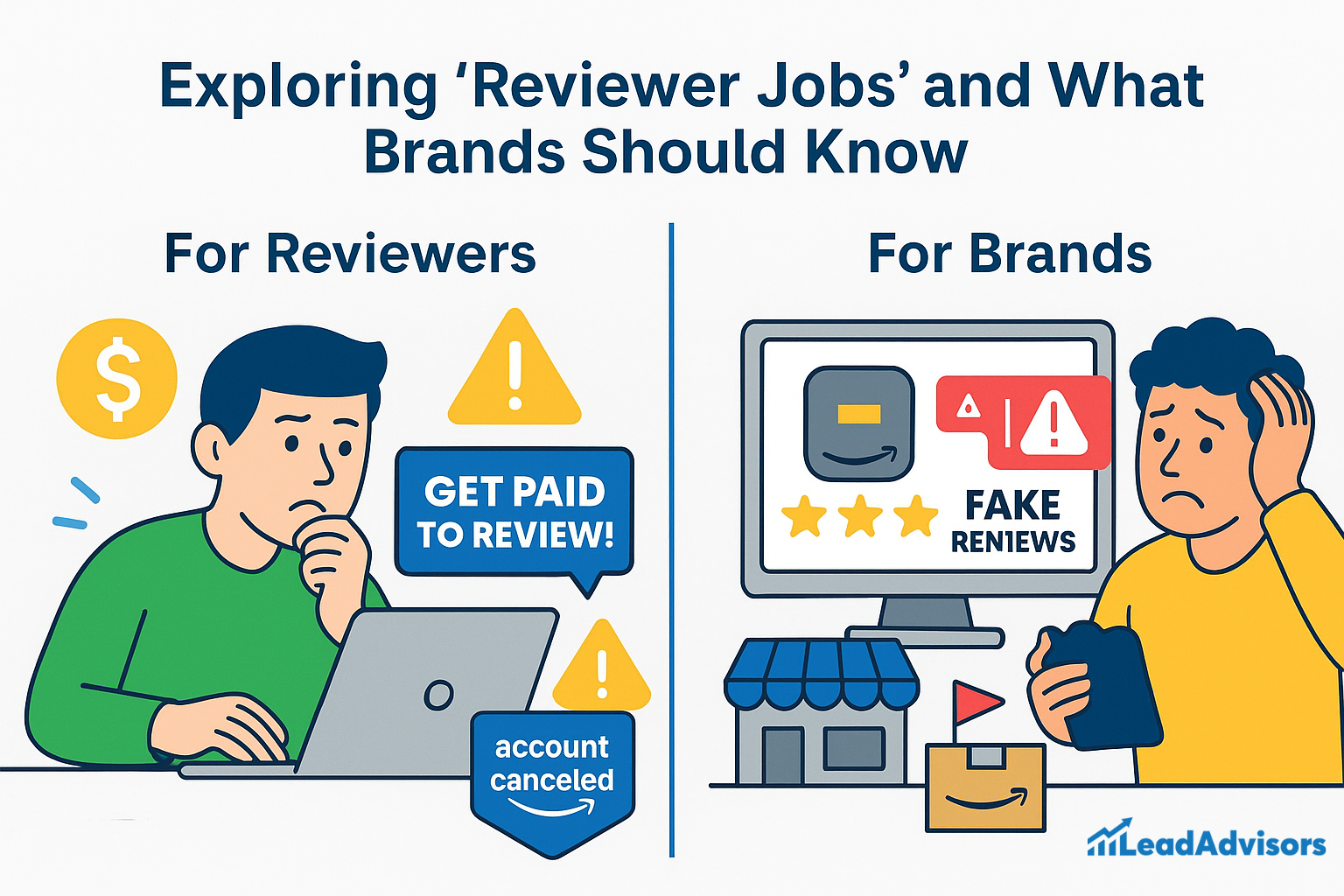
It’s a nice enough idea on the surface, but here’s the reality: Amazon doesn’t employ reviewers. That role doesn’t exist.
What you’re really looking at are third-party “opportunities” posted by outfits or manufacturers hoping to inflate their listings. These aren’t official. And they are certainly not safe.
Here’s the way it typically works:
For Reviewers | For Brands |
These gigs are usually freelance or one-off | Paying for fake reviews is a shortcut with real consequences |
Often low-paying (if they pay at all) | Your product page can disappear |
Usually sketchy when it comes to Amazon’s Terms of Service | Your listing may get penalized |
You could get flagged or banned from your Amazon account | Your storefront could be banned |
There’s no oversight, transparency, or way to guarantee quality reviews. | |
Once buyers notice fake reviews, trust is gone |
That’s why this type of “review job” isn’t worth the risk.
Not for customers. Not for brands.
I’d say that if you’re a reviewer, ethical programs like the Amazon Vine Program are your best bet. And if you’re a seller looking to establish some credibility, your job is to get real, honest feedback from real customers.
No gimmicks. No shortcuts. Simply useful reviews.
Affiliate Editorial Reviews: A Smarter Alternative for Brands
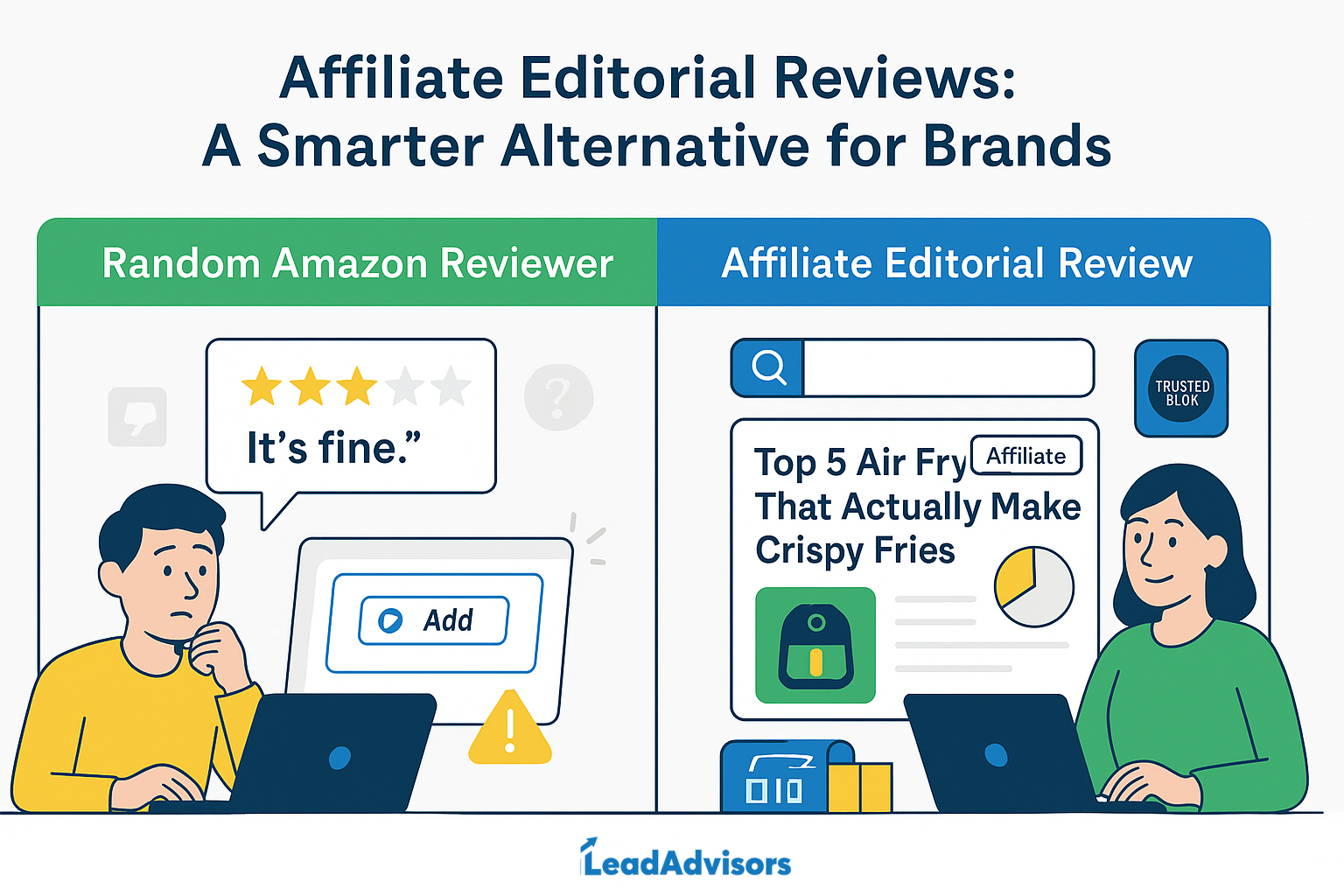
You just never know what you’ll get when you’re leaning on random Amazon reviewers. You might”¦ get lucky”¦ but you could very well get a perfunctory review that does not do much to help. If you are a brand searching for control, consistency, and real results, affiliate editorial reviews are the wiser choice.
So, what are affiliate editorial reviews?
They’re not the standard review of a customer who wrote five words and is out the door.
These are:
- Expert-written reviews
- Featured on High authority websites
- To boost web traffic and sales
- Typically, a part of an affiliate relationship (they earn a small commission when someone clicks over and makes a purchase)
Think:
“Best Noise-Canceling Headphones of the Year — Ranked by Audio Engineers”
“Top 7 Ergonomic Chairs for Remote Workers—Backed by Chiropractors”
These write-ups resemble helpful, editorial content — they’re not ads! — and they exist on pages people trust (like a tech blog or parenting site, or finance publication).
Why affiliate editorial reviews are better than chasing random reviewers
Let’s break it down:
Random Amazon Reviewer | Affiliate Editorial Review |
You don’t know what they’ll say | You guide the messaging (while keeping it honest) |
Reviews can disappear or get buried | Articles are searchable and evergreen |
No SEO value | Articles are optimized to rank on Google |
Minimal brand storytelling | Highlights your product’s features, benefits, and use cases |
Little trust or credibility | Published on trusted media outlets or industry blogs |
What makes this work?
✅ You control the narrative
✅ SEO is built in
✅ Readers trust the source
✅ Content is discoverable even after publishing it
That means you’re not just a one-time jump in reviews but long-term brand exposure.
Real example: Let’s say you sell an air fryer
- Instead of sending a freebie and crossing your fingers for a 3-sentence Amazon review…
- You partner with LeadAdvisors to be profiled in an article such as:
“Top 5 Air Fryers That Actually Make Crispy Fries” - That article is posted on a popular lifestyle blog.
- The review also gets linked right to your Amazon page.
- All the clicks and sales are tracked, and your product is placed in the best possible light in a well-written piece that people trust.
How LeadAdvisors Helps Brands Win with Editorial Reviews
Let’s face it — it is hard to get noticed on Amazon. With so many brands fighting for clicks, it’s not enough to rest on the accolades of your customers and hope for the best.
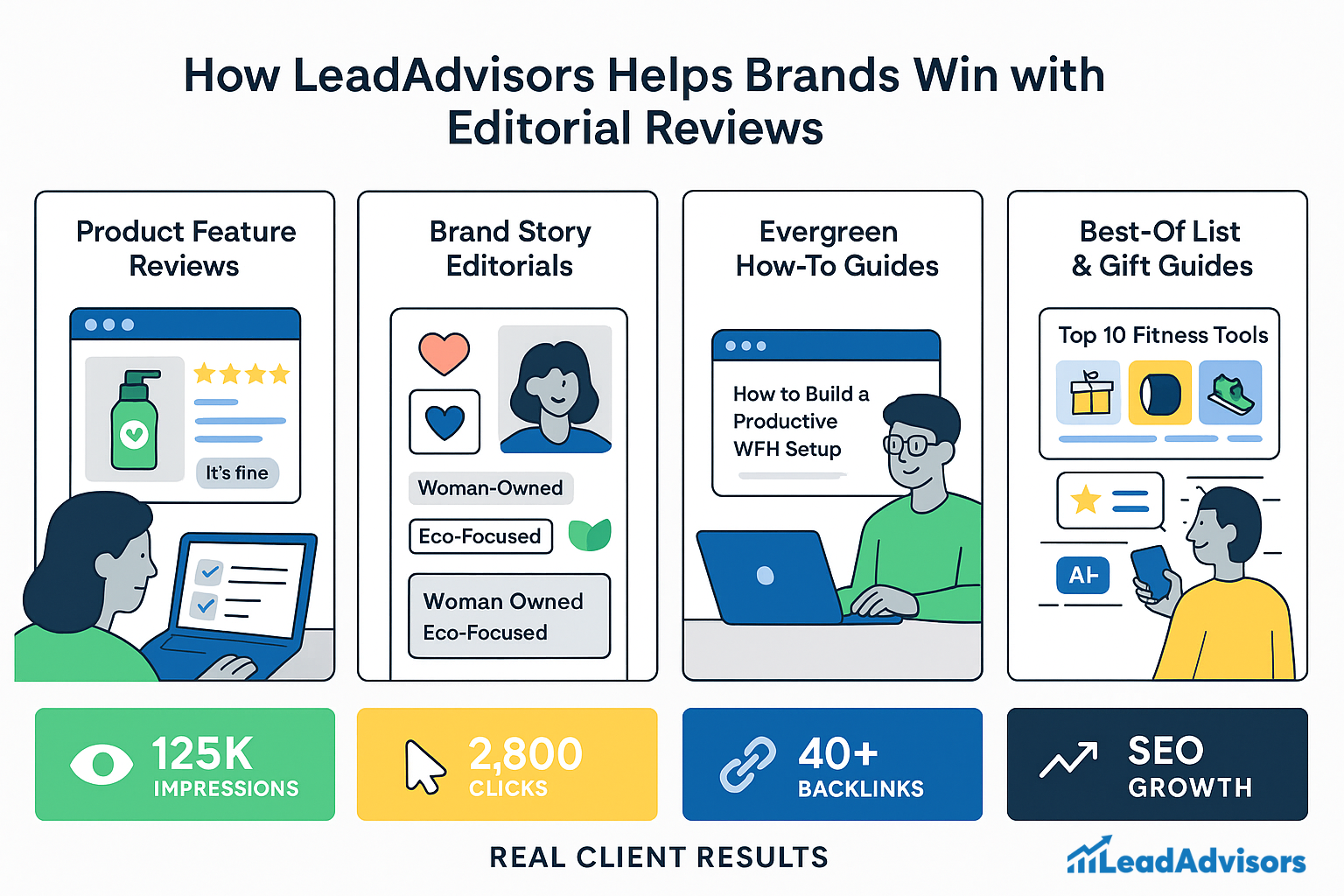
That’s where LeadAdvisors comes in.
We help brands escape from the randomness of shopper feedback and into the world of media-backed exposure with EDITORIAL REVIEWS that actually CONVERT.
Types of Editorial Placements We Offer
We’re not one-size-fits-all content. Instead, we customize editorial placements to the development stage of your brand, product category, and long-term marketing needs.
Here’s what that looks like:
Product Feature Reviews
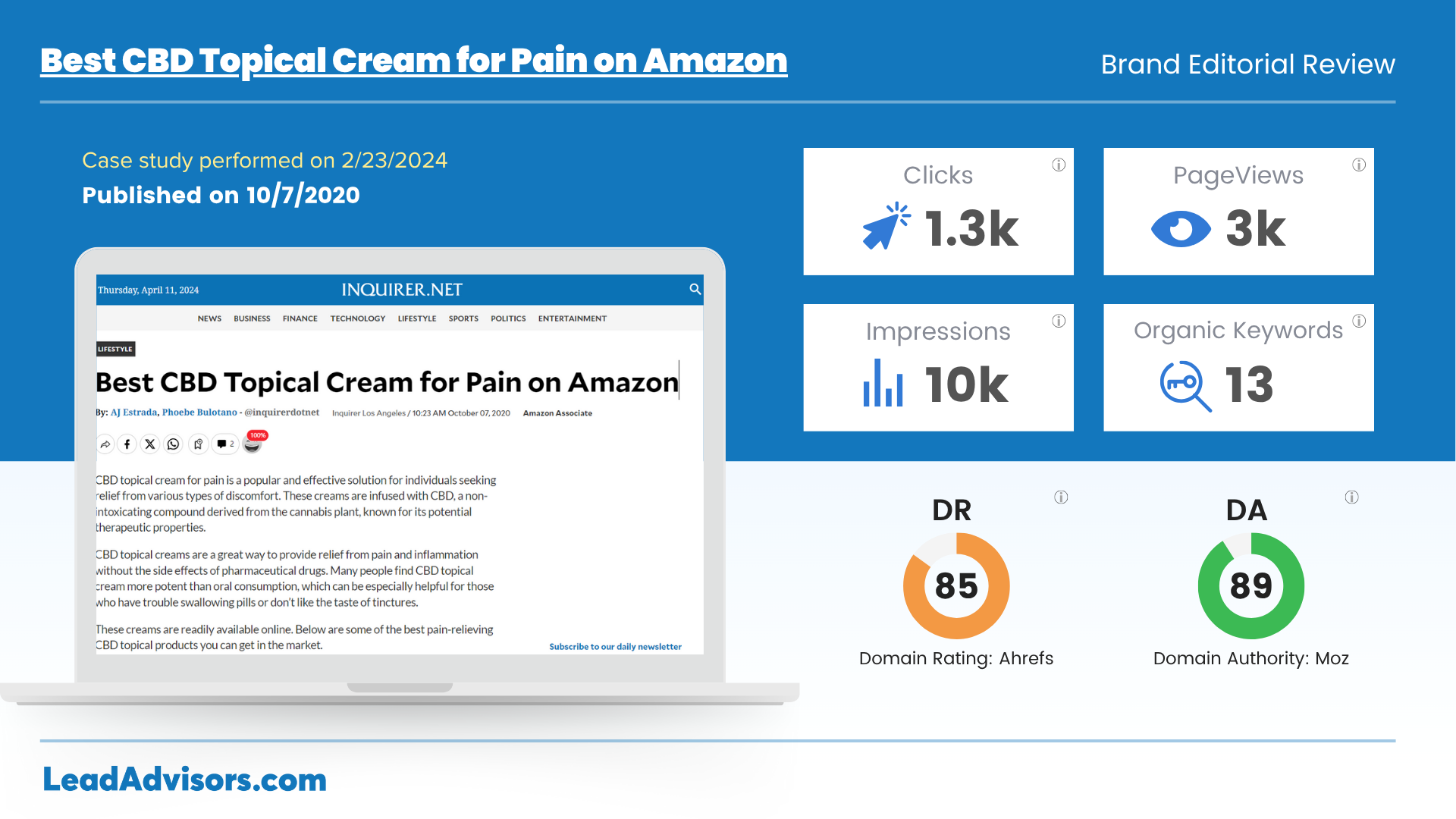
These are deep dives into your best-selling or new items. They’re calling out to people, pointing out the features, use cases, and benefits of the product in a way that makes readers think, “Okay, this is what I’ve been looking for. No matter if you’re hawking tech gear, skincare, or kitchen implements, this template puts your product in the limelight where it belongs.
Brand Story Editorials

Your product can be awesome, but the story is what people remember. These editorials will express the “why” of your brand. Perhaps you’re eco-focused, woman-founded, family-owned, or have been influenced by personal experience. This humanizing copy helps people relate to your brand emotionally and stay in the game longer.
Evergreen How-To Guides
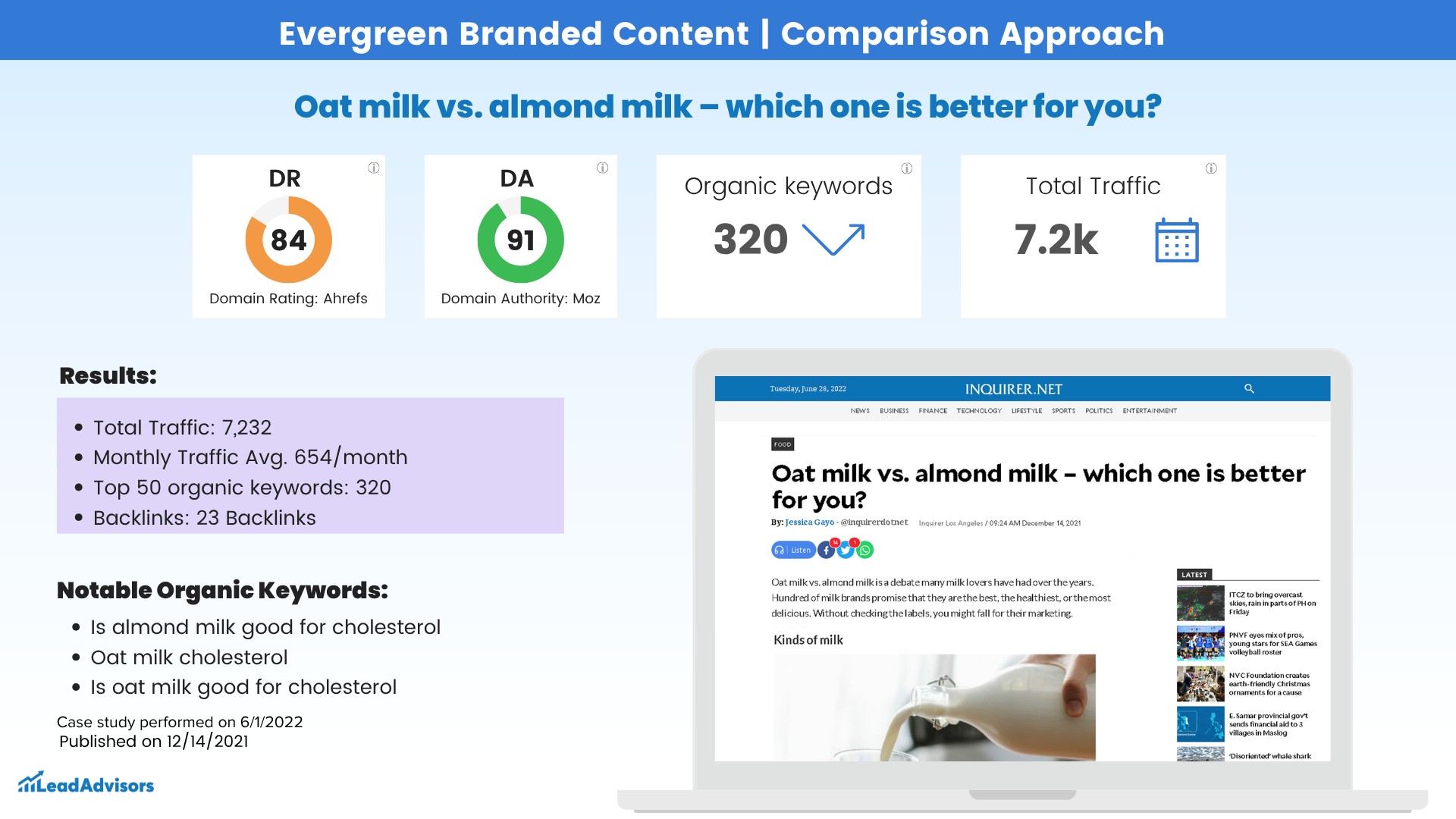
This format first addresses a problem, and then fills in your product as the natural solution. Think “How to Build a Productive WFH Setup” or “What You Really Need in a Skincare Routine.”
These can be super successful for niches or things like educational products, and are still producing organic traffic months/years after publishing.
Best-Of Listicles & Gift Guides
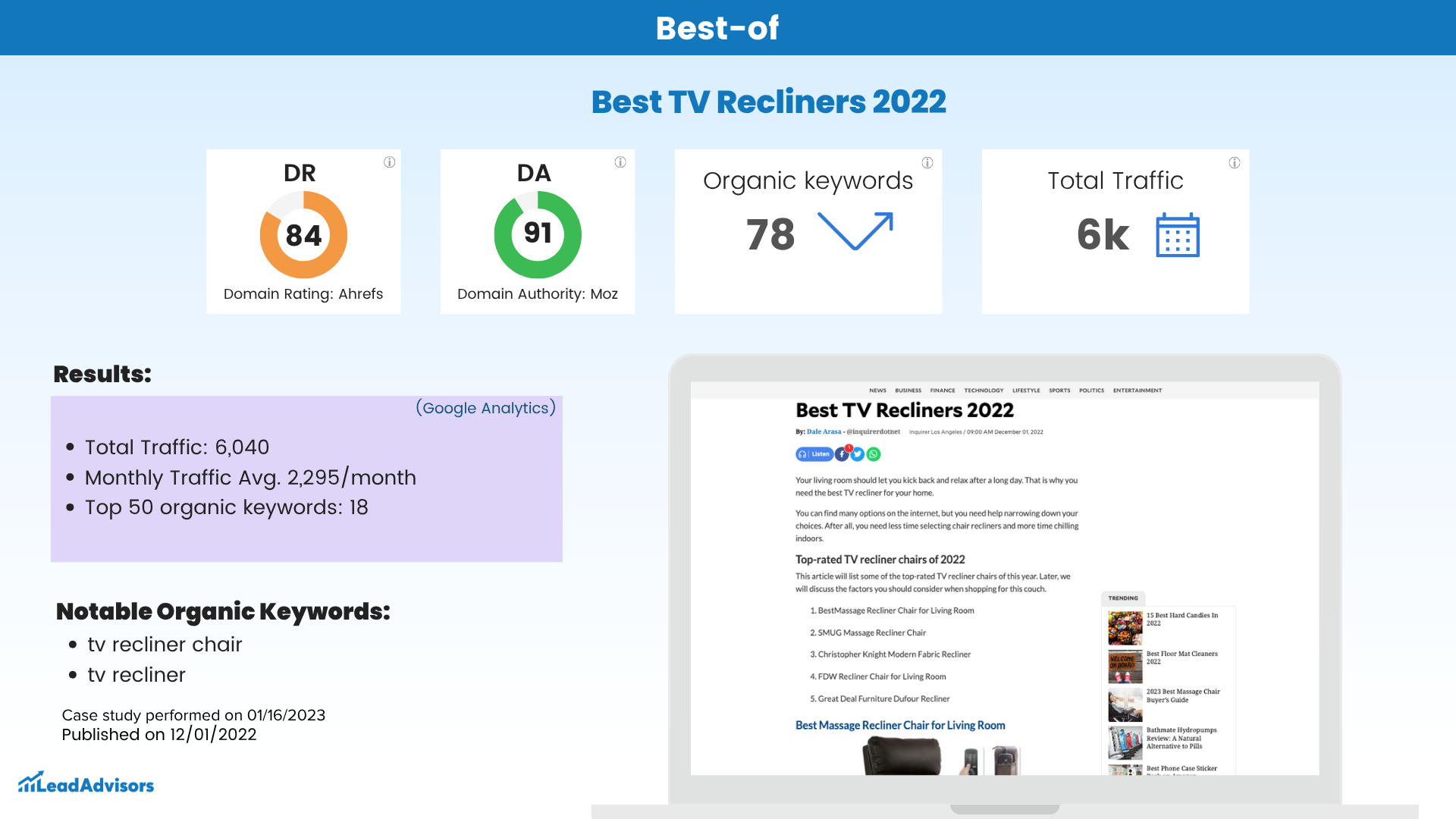
Ready to appear where people are actively searching to buy? These seasonal or hand-curated roundups are great. “Best Gifts for New Dads” to “Top 10 Fitness Tools You’ll Actually Use” is where your product sits under a family of trusted recommendations. Ideal for holiday pushes, product launches, or campaigns associated with trending moments.
Real Results from Real Clients
📈 A strategic seasonal fashion listicle titled “Best Shoes for College Guys” didn’t just bring clicks—it built lasting SEO value.
✅ Published on a DA 91 authority site, this product category review earned:
- 73,000+ impressions
- 1,967 total traffic (and counting)
- 640+ average monthly visitors
- 10+ high-quality backlinks from niche-relevant domains
- Avg. time on page: 5 minutes, 2 seconds
- Top 25 keyword rankings with a solid 2% CTR
- Continued organic growth quarter after quarter
This campaign succeeded because the content was strategically optimized for long-tail seasonal keywords such as “best shoes for college” and “college guy shoes,” capturing particular search intent.
The article featured an engaging, affiliate-friendly layout that encouraged clicks and conversions, while its timely publication ahead of the back-to-school season aligned perfectly with peak search demand.
Want to skip the guesswork?
Looking to get your product reviewed by media, not random shoppers?
Let’s talk. Visit leadadvisors.com
Amazon Vine vs. Affiliate Editorial Reviews (Side-by-Side Comparison)
Feature | Amazon Vine | Affiliate Editorial Reviews |
Reviewer Control | No control—Amazon selects the reviewers | Full control over who writes and how your product is positioned |
Review Placement | Appears on your Amazon product page | Published on high-authority media sites |
SEO Impact | No SEO benefit | Built for SEO—drives long-term organic traffic |
Longevity | Short-term visibility | Evergreen content with lasting discoverability |
Cost | Free product | Strategic investment for long-term ROI |
Narrative Control | No say in messaging | Full narrative and tone control |
Targeting | Random Amazon-selected reviewers | High-intent shoppers actively searching for recommendations |
Who Should Use Which?
Not all review tactics work for all stages of the game. Here’s how to tell what makes the most sense for your brand or business:
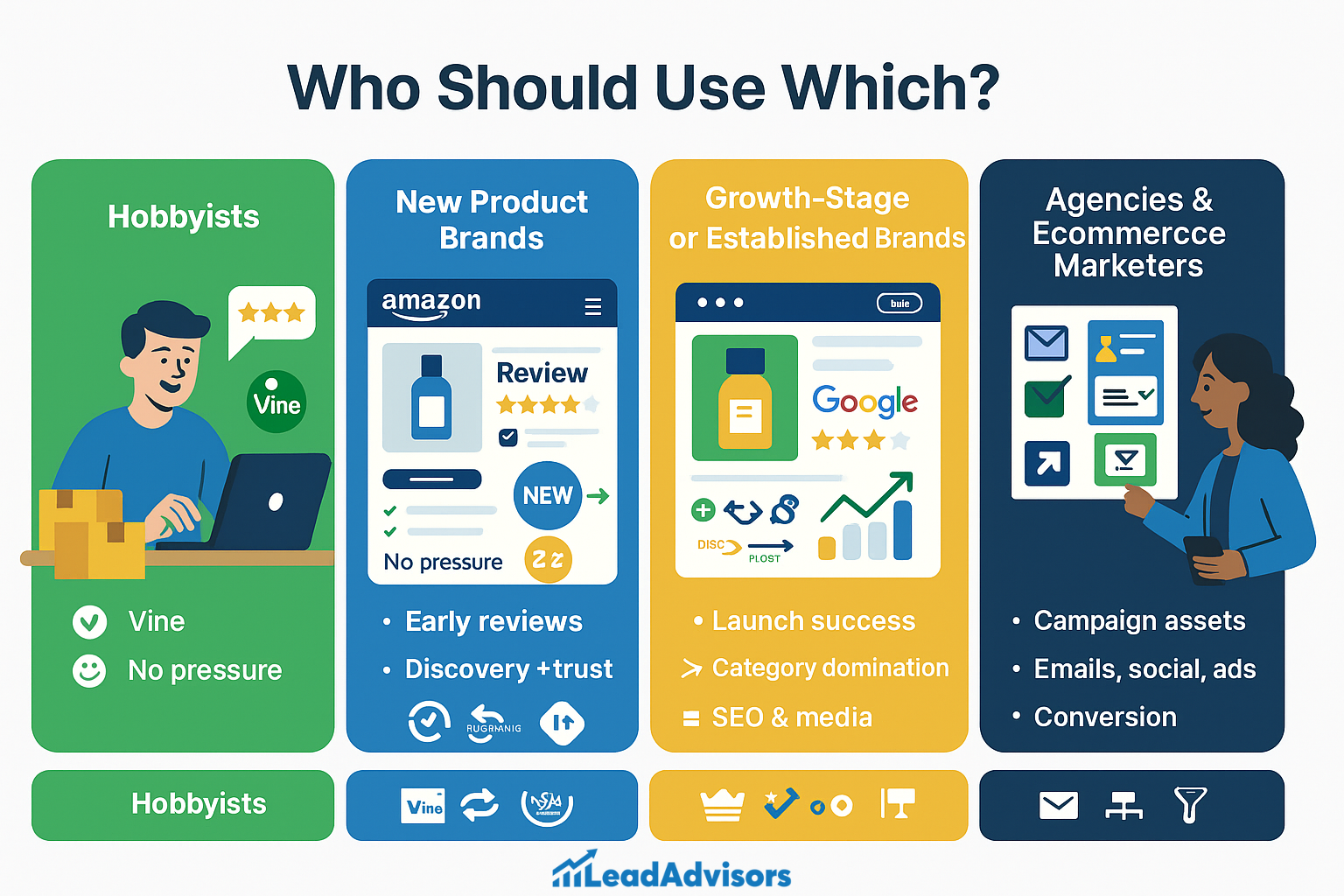
Hobbyists
If you’re reviewing as a side hustle (or just because you love getting new stuff), Amazon Vine or organic reviews are solid places to start. It’s pressure-free, and you can establish yourself as a credible product reviewer without any up-front investment.
New Product Brands
Have you just launched something new? Do both–use Amazon Vine to seed your product page with early reviews … and then run affiliate/editorial on your product page to build trust on Amazon and long-term visibility. You will cover both discovery and validation.
Growth-Stage or Established Brands
If you’re scaling or already have traction, focus on editorial reviews. Those provide a higher sense of control to your brand voice, generate SEO traffic, and give you credibility through established media placements. They’re perfect for product launches, category domination, and retargeting.
Agencies and Ecommerce Marketers
Editorial reviews become content assets that you own and can repurpose in emails, social media, and ad campaigns. If you’re constructing a full-funnel strategy, these reviews do double duty—generating trust up top and converting clicks down the line.
How to Get Started
Whether you want to do reviews or have your brand be reviewed, the place to start needn’t be difficult. Here’s how to begin, based on your role:
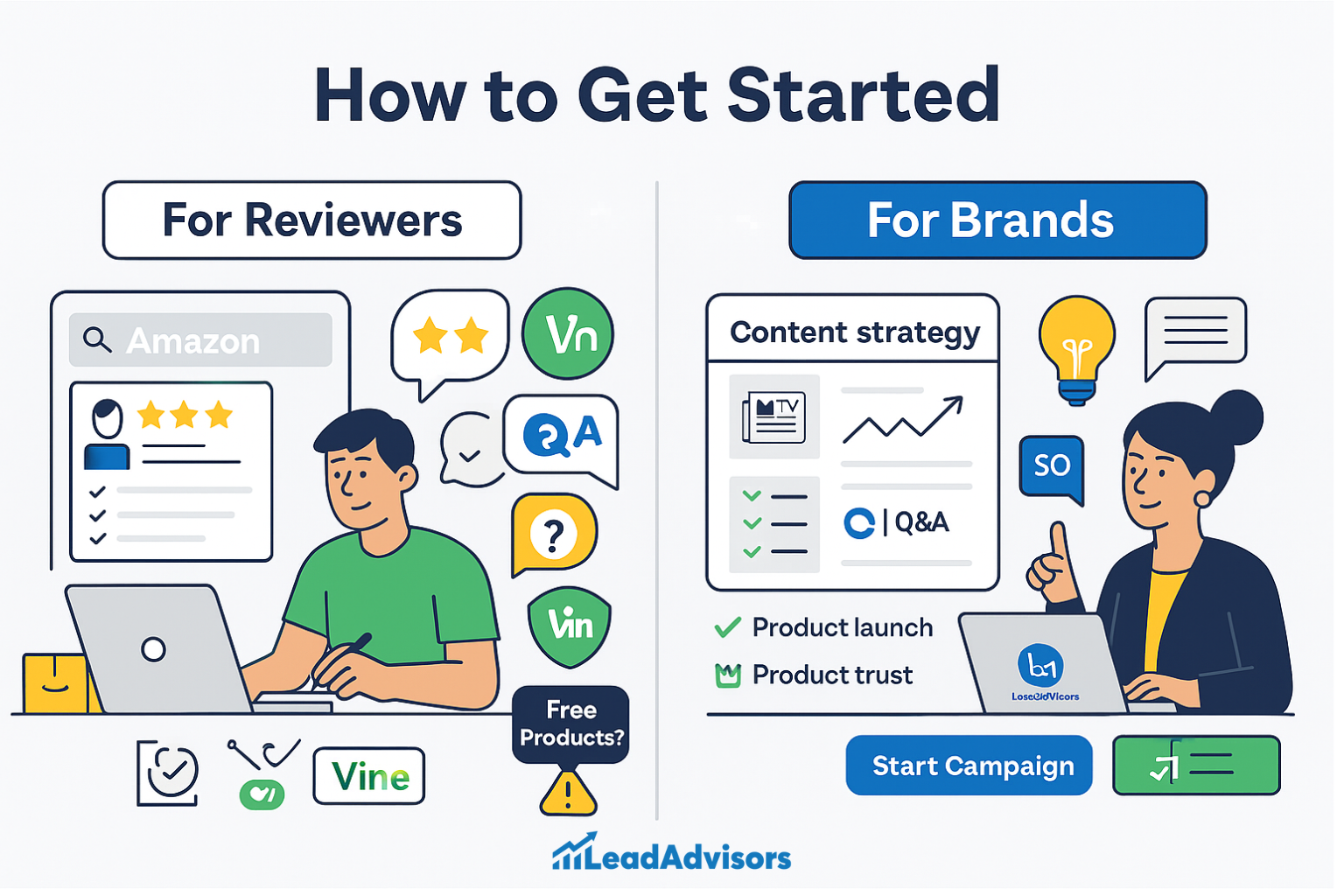
For Reviewers
Just getting into product reviewing? Start small and build your credibility:
- Review your past Amazon purchases
Provide honest and unbiased reviews — what did you love? What could be better? How did this product meet your expectations? Amazon prefers quality over quantity. - Explore third-party product tester programs (carefully)
Some programs give you free products or early access, but make sure they also comply with Amazon’s policies. If something seems too good to be true or just feels 5-star, don’t believe the hype. - Build your presence
Join the conversation about your book on Amazon’s Q&A sections, participate in other reviews, or share content on review sites, blogs, or YouTube.
For Brands
Ready to get your product in front of shoppers who are already looking?
- Work with a placement partner like LeadAdvisors.
We excel at securing your brand’s strategic editorial placements on media sites your audience actually reads. - Define your strategy
Know who you’re speaking to, select your focus keywords, and decide what aspect of your product makes it unique – be it the innovation, the value, or how it fits into your lifestyle. - Launch your first campaign with expert support
We handle everything from content strategy and media outreach to SEO optimization so that your product is placed where it matters most.
Wrapping It Up
Whether you’re reviewing products or trying to get your brand noticed, the goal is the same: build trust and deliver value.
Amazon Vine is a solid starting point for early product feedback, but if you’re aiming for long-term results, like better SEO, lasting visibility, and full message control, affiliate editorial reviews are the smarter play.
At the end of the day, it’s not just about getting reviews. It’s about getting the right kind of exposure.
Want your product reviewed by trusted media, not random shoppers?
Schedule a free strategy call → leadadvisors.com

